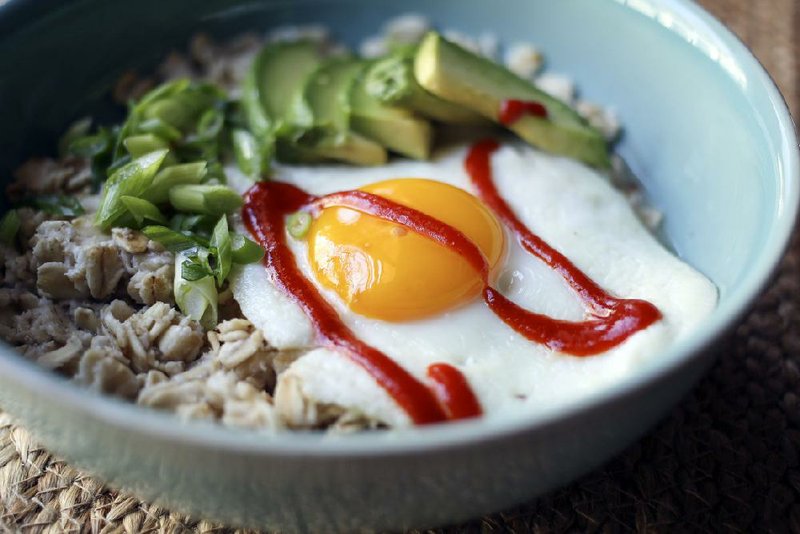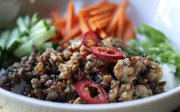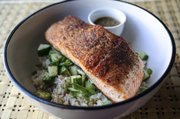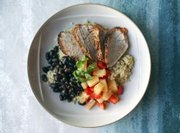A reader recently left us a message requesting a story on "bowl food," including recipes and cookbooks. And while it's possible he was referring to food you might watch during a football bowl game, we're pretty sure he was referring to the current trend of complete meals served in bowls.
Technically speaking, almost any meal you'd serve on a plate that features a protein, vegetables and a grain can be turned into a bowl by simply -- yes -- serving it in a bowl. But there's more to it than that.
Bowl food is comforting and filling. It can be ultra-nutritious -- think heath nut food -- but it can also be indulgent -- cheesy, beefy, beans and rice.
Bowls can be eaten at breakfast or dinner or anytime in between.
Said bowls are known by a variety of names -- Buddha bowls, grain bowls, nourish bowls, hippie bowls, burrito bowls -- depending on their predominant flavors. We've even seen recipes for breakfast bowls -- usually parfaitlike creations or dolled-up oatmeal.
And bowls are everywhere these days.
At least once a week a friend posts a picture of their latest bibimbap on social media.
Bibimbap is a Korean dish meaning mixed rice. A typical bibimbap might include rice, individually sauteed and seasoned vegetables (usually a combination of beans, sprouts, carrots, spinach and mushrooms), gochujang (Korean chile paste), spiced beef and an egg.
Burrito bowls, though less authentic, rank among the most popular items at restaurant chain Chipotle (according to our informal observations). For those not in the know, a burrito bowl typically contains all of the ingredients one would find in a burrito, minus the tortilla and served in a bowl.
Even the president is on the bowl bandwagon. Remember last year when then-candidate Donald Trump made waves when he tweeted a photo on Cinco De Mayo of himself eating a taco bowl (aka taco salad)?
You've probably been eating bowls without even realizing it. Chili over rice topped with diced onion, jalapeno and cheese is an example. At my house we've even been known to turn pot roast into a bowl by serving it over mashed potatoes, polenta or rice with a variety of roasted vegetables.
Bowl food, like its cousins main-dish salads and soups, makes great use of leftovers. From leftover proteins to odd bits of fresh vegetables or the lonely tablespoon of nuts.
Speaking of salads ... what exactly is the difference between a bowl and a salad? The short answer: lettuce. A salad is built on a bed of lettuce. Bowls are built on grains. But temperature seems to play a role too. Salads are typically served chilled or at room temperature, whereas a bowl's filling is often served warm.
The downside of such a versatile food is how many -- and we do mean many -- ingredients it takes to do them well.
There's the grain (plus the cooking liquid and seasoning). There's the protein (plus its seasoning and required cooking method). There are the vegetables. The toppers such as cheese, nuts, seeds or fresh herbs. And then there's the sauce.
It's easy to end up with an ingredient list a page long. We've seen bowl recipes that call for upward of 25 ingredients!
That's where planning and using leftovers are key.
The best bowls include a variety of complementing textures and flavors and combine cooked and raw ingredients.
How to build a bowl:
Pick a grain/starch such as rice, quinoa, noodles, barley or bulgar.
Pick a protein such as chicken, beef, tofu, eggs or fish and/or a legume such as beans, lentils or peas.
Pick a vegetable -- roasted, grilled, sauteed or raw -- or five.
Pick some toppings such as toasted nuts, seeds, fresh herbs, cheese, diced avocado, raisins, pomegranate arils or crumbled bacon.
Pick a sauce.
Layer in order listed in a wide bowl and top with sauce.
Serve hot or cold.
For more recipes and ideas, check out the following books:
• Nourish Bowls: Simple and Nutritious Balanced Meals in a Bowl (no author listed) from Quadrille Press
• Grain Bowls: Bulgur Wheat, Quinoa, Barley, Rice, Spelt and More by Anna Shilinglaw Hampton
• The Sprouted Kitchen: Bowl + Spoon by Sara Forte
Spicy Chicken Bowls: Cook rice or quinoa according to package directions. Coat boneless, skinless chicken breasts with a mixture of cumin, chile powder and minced chipotle in adobo. Brown on both sides in a hot skillet in olive oil. Transfer chicken to a foil-lined baking sheet and bake 15 to 20 minutes in a 350-degree oven until
the internal temperature reaches 165 degrees. Cut into thin slices. Meanwhile, saute strips of red and yellow bell pepper and red onion in olive oil. Set aside. In the skillet used to cook the peppers and onion, cook frozen corn kernels 5 minutes or until heated through. Transfer to a bowl. Season with lime juice and oregano. Stir in some diced avocado. To serve, layer rice or quinoa, sliced chicken and peppers and onions in individual serving bowls. Top each with avocado-corn mixture, diced tomato, some shredded cheese, fresh cilantro and a drizzle of hot sauce or salsa. (This combination would work great with leftover steak in place of the chicken.)
Savory Breakfast Bowls: Layer cooked oats, rice, quinoa or buckwheat in individual serving bowls. Season grain with soy sauce. Top each bowl with a fried egg, 1/4 of an avocado (sliced), a sprinkle of sliced green onion tops and a drizzle of sriracha or other hot sauce.
Chicken, Chickpea and Avocado Grain Bowls: Season a drained can of chickpeas with cumin, ground red pepper (cayenne) and salt. Heat enough olive oil to coat in a medium skillet, add seasoned chickpeas and cook, stirring or shaking pan occasionally, until chickpeas are browned and crisp, about 10 minutes. Drain on paper towels. In a food processor or blender, combine 1 1/2 cups parsley leaves, 3/4 cup mint leaves and pulse to finely chop. Add 1 1/4 cups olive oil, 6 tablespoons lemon juice, 1 teaspoon honey and a generous pinch of salt and pulse to combine. Toss 1/2 cup of the dressing with 4 cups cooked quinoa, rice, barley, bulgur or wheat berries. Divide grain among 4 bowls. Toss the meat from a rotisserie chicken with 1/4 cup of the remaining dressing. Divide chicken and spiced chickpeas among individual bowls. Top with a bit of sliced cucumber, sliced avocado, pickled red onion and a sprinkle of sesame seeds. Serve with remaining dressing on the side for drizzling. Recipe adapted from eipcurious.com
Cuban-inspired Pork Bowl With Pineapple Salsa
1 pork tenderloin
Cuban spice blend (garlic powder, onion powder, orange zest, lime zest, oregano, cumin and black pepper)
Olive oil
5 green onions
1 cup diced fresh or canned pineapple
1/2 red, yellow or orange bell pepper, diced
1/2 chile pepper, minced
Juice of 1/2 small orange
Juice of 1/2 lime
Salt and ground black pepper
2 cups cooked grain such as rice or quinoa
1 1/2 cups cooked black beans (canned is fine)
Shredded mild cheese such as Monterey Jack or provolone, optional
Heat oven to 425 degrees. Season pork on all sides with Cuban spice blend. Coat a cast-iron skillet or roasting pan with a bit of olive oil. Place pork in skillet or pan. Roast in oven until pork reaches an internal temperature of 145 to 155 degrees. Let rest 5 minutes. Thinly slice.
Meanwhile, finely chop the green onion, reserving 2 tablespoons of the bright green tops. Stir together the pineapple, bell pepper, chile pepper and remaining green onion. Stir in orange and lime juices; season with salt and pepper.
To assemble: Layer grain, beans and pork in individual bowls. Top with pineapple mixture and sprinkle with green onion tops and cheese, if desired.
Make about 4 servings.
Variation: Substitute 1 fresh mango, peeled and diced for the pineapple.
This recipe also works with ground chicken or turkey.
Vietnamese-inspired Caramelized Pork Bowl
1 1/2 tablespoons vegetable oil
1/2 onion, finely diced
2 teaspoons grated fresh ginger
2 cloves garlic, crushed
1 to 2 teaspoons minced lemongrass, optional
1 hot chile, minced PLUS a few slices for garnish
1 pound ground pork (or turkey or chicken)
5 tablespoons brown sugar
2 tablespoons fish sauce
Cooked rice or vermicelli noodles, for serving
1 to 2 green onions, thinly sliced on the diagonal
1 cup cucumber matchsticks
1 cup carrot matchsticks
Heat the oil in a large skillet over high heat.
Add the onion, ginger, garlic, lemongrass (if using) and chile and cook for 2 minutes.
Add the pork and cook 3 minutes or so, until white all over, breaking up the meat with a wooden spoon.
Add the sugar and fish sauce. Stir, then leave it to cook without stirring until all the juices cook out, about 2 minutes. Then stir it and leave it again for 30 seconds. Repeat twice more until the sugar is caramelized and the pork is a deep, rich brown.
Serve over rice or vermicelli noodles, garnished with green onion, cucumber, carrots and sliced chile, if desired.
Makes 4 servings.
Recipe adapted from recipetineats.com
Teriyaki-Glazed Salmon, Cucumber and Avocado Bowls
4 (5-ounce) salmon filets
Salt and ground black pepper
1 tablespoon vegetable oil
4 cups cooked rice
1 avocado, diced
1 Persian/Japanese cucumber OR 1/2 English cucumber, diced (see note)
1 bunch green onions, thinly sliced
1/2 cup homemade or bottled teriyaki sauce, warm or at room temperature
Furikake seasoning, shichimi togarashi seasoning blend and/or toasted sesame seeds for garnish
Press salmon filets between paper towels to dry thoroughly. Season all sides with salt and pepper.
Heat oil in a large skillet over medium-high heat until shimmering. Add salmon, skin side down. Immediately reduce heat to medium-low. Cook, pressing gently on the salmon to ensure good contact with pan, for 6 minutes or until the skin is crisp. If fish does not release easily from skillet, continue cooking until it releases. Flip and cook on second side until salmon reaches an internal temperature of 120 to 130 degrees. Transfer to a paper towel-lined plate.
Divide rice evenly among 4 bowls. Top with diced avocado, cucumber and green onion. Top each with a salmon filet. Spoon teriyaki sauce over salmon. Sprinkle with furikake, shichimi togarashi and/or sesame seeds. Serve immediately.
Makes 4 servings.
Note: Persian and English cucumbers have very thin skins and relatively few seeds.
Recipe adapted from Seriouseats.com
Food on 03/08/2017




